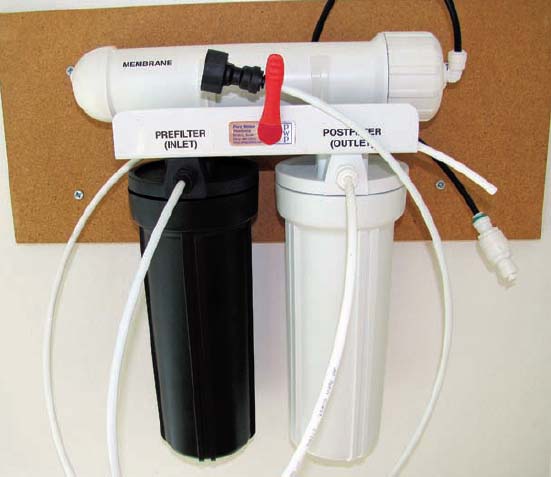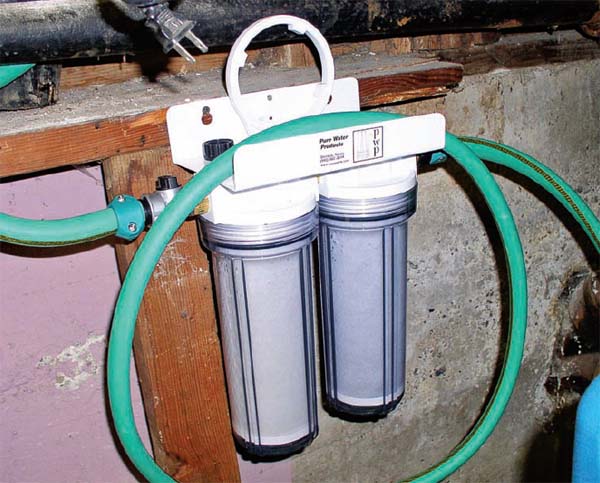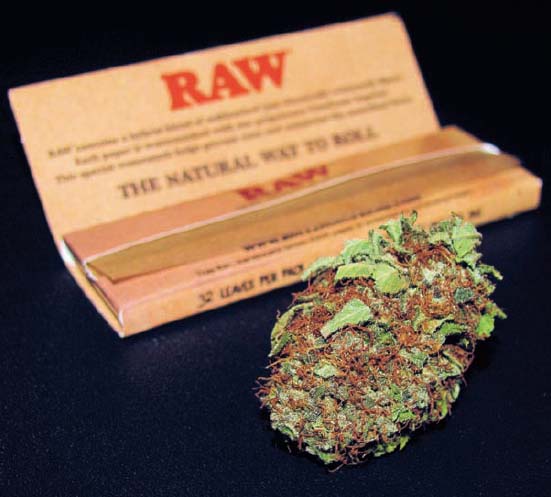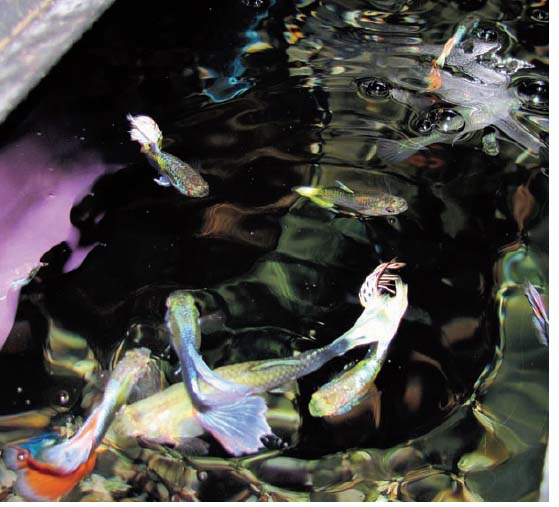
I love my tabletop reverse osmosis (RO) filtering unit!
Arguably one of the most important fundamental practices in TLO container growing is watering twice. This can have a huge influence on root health as well as mineral absorption. Here’s how it works: you water with plain water, lightly, until you see some water run out the bottom of the container. Then wait for at least 1 hour (I often wait a couple of hours) then water again until you see drainage from the bottom. This evenly saturates the container soil mix and the roots. If you do not do this, the roots will actually start guiding the water flow through the container and you will end up with dry spots that are bad for roots, and bad for plants, especially when container growing!
I like to have trays underneath my containers so that any water that drains out initially gets sucked back up into the soil mix through the process of capillary action. There’s no real need to flush when growing TLO container-style, unless you are prone to overusing liquid nutrients, or your water is fairly high in dissolved salts/solids. If you overdose your plants with liquid nutrients, you can usually flush these out in time if you catch the problem right away. Higher TDS/ PPM levels like the ones found in city tap, well and spring water will accumulate salts around the root zones of the plants, and will end up strangling them if you don’t do regular flushing.
Okay, no more Mr. Nice Guy—just get one of these and you will solve so many of your problems if you are using well, spring, or city tap water, and trying to grow organically in containers. If you have no problems, then by all means, don’t change anything, but if you do have problems, reverse osmosis filtering is likely much easier and cheaper than you anticipate it will be. A countertop reverse osmosis filtering unit (R/O filter) comes with 3 filtering chambers. Two are used for carbon filters, and one is the actual reverse osmosis membrane that removes dissolved salts/solids. First the water hits the pre (carbon) filter, then the R/O membrane, then the post (carbon) filter and mine makes about 2.5 gallons per hour. I get my filters from Pure Water Products, and these guys will set you up with a garden hose attachment free for the asking. I use their “Style A” countertop R/O Filter. I replace the pre filter once every 6 months, and the post filter once per year. The R/O membrane filter lasts for 3 years or so.

This carbon filtering unit removes chloramine among other things
Here’s the link to Pure Water Products’ website: their shipping is free in the USA: http://www.pwgazette.com/ I use the Style A countertop Reverse Osmosis Machine, with a free garden hose attachment. I also use their carbon filters, which are designed to remove chlorine/chloramine from 20,000 gallons of water, and they’re about $20.00 USD each.
Here are a few great tips about using reverse osmosis units in order to get the most out of them for the longest time. First, get a TDS meter to see when you actually need to change your R/O membrane. Also see “Softened Water” in the Troubleshooting section of this book. I would also always recommend using some kind of sediment filter before the R/O unit. If your water is “hard” and above, say, 150 PPM on a TDS meter, then you can install a water softening unit to make your R/O Unit last much longer. NEVER use straight softened water on your plants; it will kill them!
PPM stands for “Parts Per Million” and it is how your TDS (Totally Dissolved Salts/Solids) meter will display the readings it takes. After I use my R/O unit my water is about 10 PPM and for any water that is 60 PPM or below you can probably get away with just using a carbon filter, for chloramine and fluoride removal. Also, the pH of the water is basically irrelevant if the water is below 40 PPM. If TDS levels are above 100 PPM, the pH starts to matter.
As your smoking appreciation becomes more and more sophisticated, your high-quality organic palate will be able to tell cannabis grown with pure water sources from cannabis grown using higher TDS/PPM water sources; hard to imagine perhaps, but absolutely true. Because of this, I always recommend pure water sources for TLO growing, and choosing rain, reverse osmosis, or distilled water will make everything that much smoother and raise the smoking quality to five star all the way! To really get a good idea of how elegant cannabis smokes, I always recommend doobies. Glassware with resin from synthetic grown cannabis will really mess up your organic smoke, so don’t screw yourself there and use a clean piece, or make it doobie-time!

TLO-grown doobies are divine!
Hard water is water that contains high levels of dissolved magnesium and calcium mineral salts. You can see the “scale” it leaves over time on your coffeemaker if you use city, well, or spring water. This will also happen to your soil mix if you water your plants with hard water. The mineral salts will collect around the root zones and build up, interfering with airflow through the soil, to the roots, and to the microlife. You need to flush regularly—every other time you water I would say—and I do not recommend using spring, well, or city water unfiltered, especially if it is hard water.
Now on the flipside, if your tap/city water comes out of the faucet at (or below) say 60 PPM you may be able to get away with using an activated carbon filter (see the single carbon filter in the picture) to remove the chloramine and the fluoride. The trick here is to let the water flow slowly through the filter unit, because how effectively/thoroughly these elements are removed is determined by the length of time the water is in contact with the carbon filter. I also have used a dual version of the filter in the picture which allowed me to thoroughly remove the chloramine and fluoride while also allowing me to run the water more quickly through the filters, and this comes in handy in larger grows.

Single carbon filters can work with low PPM water
Water collected by dehumidifiers is essentially distilled water, and is fine to use in my experience as long as you keep the unit clean around the collection areas. Rainwater is my number one favorite to use in TLO growing, and if you have that option then use it, you lucky devil! If you collect rainwater off your roof, do some checking into the type of roof you have, because there are types of shingles that will leach out chemicals into the rainwater. If your roof is all good, by all means set yourself up to collect the water from there into storage tanks under or above ground where the water can be stored while being aerated with air pumps.
There are many resourceful ways to collect rainwater, and when I was a guerrilla grower outdoors, we would even set up collectors made from tarps tied to trees. We would then fill waterbed mattresses. Where there’s a will, there’s a way! Rainwater is the best you can get in my opinion, and is full of all kinds of beneficial elements and even microbial life. I could devote a lot of pages to rainwater, but let’s just say that this is the water you seek for the ultimate five star connoisseur buds, in my humble opinion. If I owned my own house I would for sure set up a rain collection system, but for now I use reverse osmosis water and get cannabis that smokes great. So as long as your water source is a pure one, for the most part, your final product will be suited for the connoisseur!

Once your palate gets used to TLO buds, you’ll be able to tell those grown with good quality water from those that weren’t!
REV’S TIP
I can’t say enough good things about rainwater. Like distilled water it is nominal in dissolved solids, and it also seems to contain microlife too; heavenly microlife! If I was using this water exclusively for TLO container growing I would almost always add about 10 drops per gallon of CaMg+ by General Organics to keep the slow and steady supply of calcium and magnesium coming to the microlife and the plants.
If your fresh water fish tank is all healthy and happy, and you don’t add chemicals to remove chlorine or anything along those lines, your freshwater fish tank water is like a giant organic tea, full of good microlife, and you should use this water when brewing your own organic teas. You need to use reverse osmosis water to fill your tank, or very low TDS water, if you want to use this water very often on your plants. If you don’t, extraneous mineral salts will build up in the rhizosphere, causing problems. I have a 55-gallon freshwater fish tank full of guppies and a huge 13-year-old goldfish. I do water changes of 10 gallons once a month using reverse osmosis water. I never add any chemicals to my water and my fish have never been sick. The living dynamic in the fish tank is on a parallel with your TLO growing containers with plants in them. The soil mix is the water with the fish being the plants, and they both depend upon high levels of good microbial life Fresh water fish tanks, as long as they’re healthy, are a great source of water!
Basically, if you have a healthy freshwater fish tank, the water in it is mega-full of good microlife! It can also be added to teas, as a bio-catalyst; I add fishy water to my teas at a rate of 1 cup per gallon of tea, and I do this about every second or third time I make a tea. Because I use pure water for my fish as well I add aquarium salts at a ratio of about 1 tablespoon per 10 gallons of reverse osmosis water, and my fish are almost as healthy as my pot plants.

Fresh water fish tanks, as long as they’re healthy, are a great source of water!
ADDITIVES FOR RECYCLED SOIL MIX
These are basic guidelines and remember that all this stuff needs to be cooked (composted) first for about 30 days before use. I will give these to you in per (dry US) gallon of soil mix amounts, so just do a little simple math to make larger amounts.
Per single dry US gallon of soil mix:
•Kelp meal: 1 tablespoon
•Blood meal: 1–2 teaspoons
•Bone meal: 1 tablespoon
•Dolomite lime powdered: 1–2 tablespoons
•Dolomite lime pelletized (prilled): 2–4 tablespoons
•Bird or bat guano (high nitrogen types): 1–3 teaspoons
•Bird or bat guano (high phosphorus types): 1–2 teaspoons
•Bulb food: 1 tablespoon
•Alfalfa meal: 1 tablespoon
•Greensand: 1 tablespoon
•Gypsum powdered: 1 tablespoon
•Gypsum granular: 2 tablespoons
•Living earthworm castings: 1 cup
•Perlite (always use small nugget size): 2 cups
•Coconut (coir) fiber (well rinsed or pre rinsed): 2 cups
•Humic acid ore (granular): 1 tablespoon
•Rice (raw): 1 tablespoon
•All purpose fertilizer like 5-5-5 N-P-K: 1 tablespoon
•Feather meal: 1–2 tablespoons
•Oyster shell (ground): 1 tablespoon
•Oyster shell (crushed): 2–3 tablespoons
•Azomite powdered (rock dust): 1 teaspoon
•Azomite granular: 1–3 teaspoons
•Soft rock phosphate powdered: 1–2 teaspoons
•Rock phosphate granular: 2–3 teaspoons